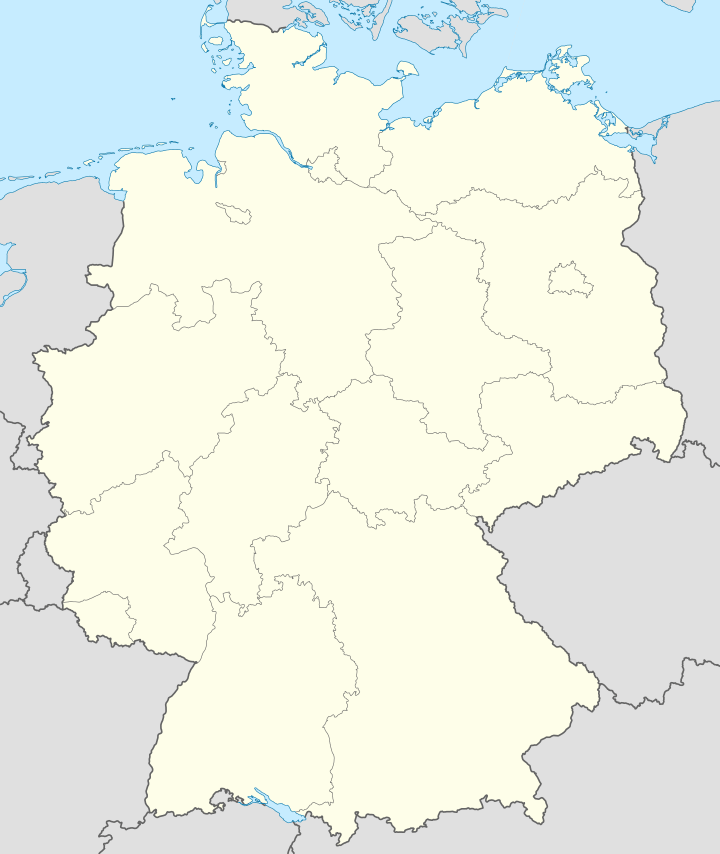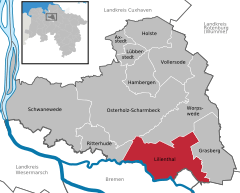Lilienthal, Lower Saxony
| Lilienthal | ||
|---|---|---|
| ||
 Lilienthal | ||
Location of Lilienthal within Osterholz district 
 | ||
| Coordinates: 53°8′N 08°55′E / 53.133°N 8.917°ECoordinates: 53°8′N 08°55′E / 53.133°N 8.917°E | ||
| Country | Germany | |
| State | Lower Saxony | |
| District | Osterholz | |
| Government | ||
| • Mayor | Willy Hollatz (Greens) | |
| Area | ||
| • Total | 72.03 km2 (27.81 sq mi) | |
| Population (2013-12-31)[1] | ||
| • Total | 18,304 | |
| • Density | 250/km2 (660/sq mi) | |
| Time zone | CET/CEST (UTC+1/+2) | |
| Postal codes | 28865 | |
| Dialling codes | 04298 | |
| Vehicle registration | OHZ | |
| Website | www.lilienthal.de | |
The municipality of Lilienthal belongs to the administrative district of Osterholz, Lower Saxony and borders Bremen (Free Hanseatic City of Bremen).
History
Lilienthal belonged to the Prince-Archbishopric of Bremen. The history of the city of Lilienthal goes back to its founding as a nunnery by the prince-archbishop Gerhard II. In 1232 construction was begun on a convent of the Order of the Cistercians under the name of Vallis Liliorum (St. Mary's Nunnery in the Valley of Lilies ), and the finished building was sanctified in 1264. During the 15th century, the cloister enjoyed a time of prosperity. After the Reformation and the conversion of the Cistercian nuns, it became a Lutheran Women's Convent, and until the end of the Thirty Years' War in 1648 it remained in deplorable conditions. In 1650, the city went through secularization. The land once belonging to the convent, which had become fragmented, developed into the small town of Lilienthal.
In 1648, according to the terms of the peace treaty that ended the Thirty Years' War (The Peace of Westphalia), the Prince-Archbishopric was transformed into the Duchy of Bremen, ruled together with the Principality of Verden, which were first ruled in personal union by the Swedish Crown. Queen Christina sent one of her commanders over, Graf Friedrich von Hessen-Eschwege, to the newly created barony (Herrschaft) of Osterholz, in which the charge of both Lilienthal and Osterholz were combined. After his early death in 1655, his wife Eleonora took over the government of the barony, with her seat in Osterholz, where she took an active role in the improvement of economic and sanitary conditions for the rural population. After her death in 1692, the barony fell back into the hands of the Swedish Royalty. Lilienthal remained a part of Swedish Bremen-Verden until 1712 (which is why the coat of arms contains the blue and yellow of the Swedish Flag), at which time it came under Danish occupation, and then in 1719 it fell under the sovereignty of the Electorate of Brunswick and Lunenburg (colloquially Electorate of Hanover), which ruled Bremen-Verden in personal union.
In 1740, the convent was destroyed.
In 1782, Johann Hieronymus Schröter became chief magistrate (or bailiff, Amtmann). In addition to this administrative office, he also played a large part in the advancement of astronomy during his lifetime. On the grounds of his office in Lilienthal, he constructed an observatory. In the following years, the Lilienthal Observatory would become the best equipped observatory in the world. One of its technological advances was the "Riesenteleskop" (giant telescope), a telescope with a 50.8 cm (20 inch) aperture and an 8.25 m focal length. Due to the telescope, Lilienthal became well-known and was sought out in matters of astronomy by government and military officials. Schröter remained in contact with many of the important astronomers of the time. Together with Wilhelm Olbers and other scholars, he founded the Astronomy Association in Lilienthal in 1800. The asteroid 3 Juno was discovered September 1, 1804 by K. Harding at the Observatory. After Schröter's death in 1816, the observatory fell into disrepair. In 1850 the remaining structure was destroyed. A large part of the observatory was sent to the University of Göttingen before the demolition.
The Befreiungskrieg (a series of battles fought between 1813 and 1815 that ended the Napoleonic Wars) hit Lilienthal hard. After an incident during a retreat, French troops set the entire town on fire. Only the church, a few houses, and the observatory escaped the flames (but the observatory was looted and important records were destroyed).[2]
After the reconstruction, the then-municipality grew steadily. In 1939 there were 3,100 inhabitants, in 1974 12,500. After the incorporation of a neighbouring town in the same year, the population grew to 17,000.
In 1823 Bremen-Verden was united in a real union with the Kingdom of Hanover and its territory became part of the Stade Region. In 1866, the kingdom of Hannover lost its independence. Lilienthal became Prussian, in 1885 the bailiwick of Lilienthal was dissolved and combined with that in Osterholz to form thenew district of Osterholz.
Schools
- Christoph-Tornée-School
- All-Day Lilienthal Haupt- and Realschule
- Falkenberg Primary School
- Frankenburg Primary School
- Seebergen Primary School
- Trupermoor Primary School
- Worphausen Primary School
- Gymnasium Lilienthal --
- Schroeterschule (Primary School)
Locality
Today, many former independent towns have been merged into Lilienthal. They include: Butendiek, Falkenberg, Feldhausen, Heidberg, Klostermoor, Lilienthal, Seebergen, St. Jürgen (itself made up of ten of its own communities: Frankenburg, Höftdeich, Kleinmoor, Mittelbauer, Moorhausen, Niederende, Oberende, St. Jürgen, Vierhausen, Wührden), Trupe, Truperdeich, Trupermoor and Worphausen (together with the previously merged villages of Lüningsee (1763), Lüninghausen (1764), Westerwede (1764), Moorende (1778), Mooringen (1778), Schrötersdorf (1805, named after J. H. Schröter) and Neu Mooringen, founded by the royal Moor Colonist Jürgen Christian Findorff, (1808)).
Twinned Cities
Since 1970, the municipality of Lilienthal has been twinned with the Dutch municipality of Stadskanaal. In 1993, the city of Emerainville in the vicinity of Paris was added.
References
- ↑ Landesbetrieb für Statistik und Kommunikationstechnologie Niedersachsen, 102 Bevölkerung - Basis Zensus 2011, Stand 31. Dezember 2013 (Tabelle K1020014)
- ↑ Staff (2002). "Astronomical Serendipity". NASA JPL. Retrieved May 20, 2011.
External links
- (German) http://www.lilienthal.de/
- (German) http://www.worphausen.de
| ||||||||
